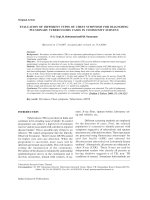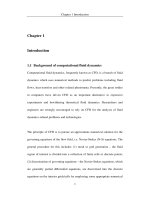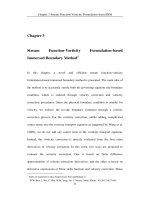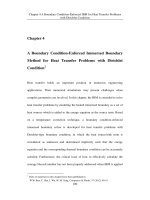Comparative evaluation of different phenotypic methods for biofilm formation among Uropathogenic E. coli (UPEC)
Bạn đang xem bản rút gọn của tài liệu. Xem và tải ngay bản đầy đủ của tài liệu tại đây (160.64 KB, 6 trang )
Int.J.Curr.Microbiol.App.Sci (2020) 9(7): 1094-1099
International Journal of Current Microbiology and Applied Sciences
ISSN: 2319-7706 Volume 9 Number 7 (2020)
Journal homepage:
Original Research Article
/>
Comparative Evaluation of Different Phenotypic Methods for Biofilm
Formation among Uropathogenic E. coli (UPEC)
Rashmi P Mahale1, M. N. Sumana2*, K. Anuradha3 and Adline Princy4
1
Dept. of Microbiology, JSS Medical College & Hospital, JSSAHER, Mysore, India
2
Department of Microbiology, MMC, Mysore, India
3
Department of Biotechnology, Sastra Deemed University, Thanjavur, Tamil Nadu
*Corresponding author
ABSTRACT
Keywords
Biofilm, Infections,
Decreased
susceptibility,
Phenotypic methods
Article Info
Accepted:
11 June 2020
Available Online:
10 July 2020
Biofilms have the ability to attach to both biotic and abiotic surfaces. With
the advent in medical industry, use of indwelling prosthetic devices have
increased abiotic surfaces providing opportunities for attachment by the
biofilm forming bacteria and thus leading to infections. Treatment of
infection by biofilm forming bacteria is difficult due to their decreased
susceptibility to antibiotics. Hence, this study was aimed to compare the
sensitivity and specificity of the three phenotypic methods for the detection
of biofilms.
Introduction
Bacteria exist in two growth modes in nature,
one as the planktonic form and the other as
sessile aggregates called biofilm. Existence in
aggregates as Biofilm confers the bacterial
community certain survival advantage like
evading the host immune responses,
resistance to antibiotics, biofilm also entraps
the nutrients for the utilizations by the
microbial community1,2. Biofilm is defined as
a structured community of bacterial cells
enclosed in a self-produced polymeric matrix
which is made up of extracellular polymeric
substances (EPS).3According to National
Institute of health (NIH) 65% of microbial
infections and 80% of the chronic infections
are due to biofilm forming microorganisms.
Biofilms have the ability to attach to both
biotic and abiotic surfaces. With the advent in
medical industry, use of indwelling prosthetic
devices have increased abiotic surfaces
providing opportunities for attachment by the
biofilm forming bacteria and thus leading to
infections associated with them like catheter
associated blood stream infections and
catheter associated urinary tract infections,
ventilator
associated
pneumonia
etc.
1094
Int.J.Curr.Microbiol.App.Sci (2020) 9(7): 1094-1099
Treatment of infection by biofilm forming
bacteria is difficult due to their decreased
susceptibility
to
antibiotics
and
unresponsiveness
to
the
standard
antimicrobial susceptibility test results which
are directed against the planktonic forms,
eradication of biofilm associated organisms
requires the determination of biofilm
eradicating concentrations which are routinely
not done. Thus, it is important to screen the
clinical isolates for biofilm forming capacity
especially in chronic infections. There are
various methods for the detection of biofilm
forming capacity of microorganisms which
includes various phenotypic methods like
Congo-red agar method (CRA), tube method
(TM), tissue culture plate method (TCP),
electron microscopy, confocal scanning
microscopy and bioluminescent assay and
molecular methods like detection of biofilm
associated genes. This study was under taken
to compare the sensitivity and specificity of
the three phenotypic methods for the
detection of biofilms.
Materials and Methods
180 E. coli isolated from clinically suspected
cases of Urinary tract infections were
evaluated for biofilm forming capacity by
three different phenotypic methods namely
tissue culture plate method, tube adherence
test and Congo red agar method. Biofilm
production by each of the methods was
graded as high, moderate, and weak, only
high and moderate graded isolates were
considered as biofilm producers, weak and no
biofilm production by each method was
considered non biofilm producers. Tissue
culture method was considered as the gold
standard for biofilm formation.
Tissue culture plate method4
Fresh isolates from agar plates were
inoculated into brain heart infusion (BHI)
broth with 2% sucrose and incubated for
24hrs at 370 c. Broth was diluted 1:100with
fresh medium, 0.2ml of this broth was
inoculated into sterile flat-bottomed microtiter
plates or tissue culture plates (TCP) only
medium was inoculated in a well which
served as control to check sterility of the
medium and nonspecific binding of media.
The TCPs were incubated for 24hrs at 370c.
After incubation contents of each well was
gently removed by taping the plates and then
were washed 4 times with 0.2 ml of phosphate
buffer saline (PBS pH 7.2) to remove freefloating “planktonic” bacteria. Biofilms
formed in wells were fixed with sodium
acetate (2%) for half an hour and stained with
crystal violet (0.1%w/v) for half an hour.
Excess stain was removed by thorough
washing with deionized water and plates were
kept for drying. Adherent E. coli formed
biofilm on all side of the wells and were
uniformly stained with crystal violet. Optical
Density (OD) of stained wells were
determined with a micro Enzyme-Linked
Immunosorbent Assay auto reader at
wavelength of 570 nm and were graded as per
Christensen et al. The OD values were
considered as an index of bacteria adhering to
surface and forming biofilms.
Experiment was performed in triplicate; the
data was then averaged and standard
deviation was calculated. To compensate for
background absorbance, the mean OD value
obtained from media control well was
deducted from all test values.
Tube adherence method5
Fresh isolates from agar plates were
inoculated into 10 ml brain heart infusion
(BHI) broth with 2% sucrose and incubated
for 24hrs at 37°C, tubes were decanted and
washed with PBS (pH 7.2) and dried. Tubes
were then stained with crystal violet 0.1% for
half an hour. Excess stain was removed and
1095
Int.J.Curr.Microbiol.App.Sci (2020) 9(7): 1094-1099
tubes were washed with deionized water and
dried in an inverted position and observed for
Biofilm formation. Biofilm formation was
considered positive when visible film lined
the wall and bottom of the tube. Tubes were
examined and biofilm formation was graded
as absent, moderate or strong. Experiments
were performed in triplicate.
Congo red agar method6
Congo red agar (CRA) was prepared by
supplementing brain heart infusion broth
(BHI) with 5% sucrose and Congo red. The
medium was composed of BHI (37 gms/L),
sucrose (50 gms/L), agar no.1 (10 gms/L) and
congo red stain (0.8 gms/L). Congo red was
prepared as concentrated aqueous solution
and autoclaved at 121°C for 15 minutes and
then added when the agar had cooled to 55°C.
The CRA plate was inoculated with the
microorganism from an overnight broth
culture and incubated aerobically at37°C for
24 to 48 hours. Black colored colonies with
dry crystalline consistency was interpreted as
biofilm producing strains. Red colored
colonies were interpreted as non-biofilm
producing
isolate.
Experiments
were
performed in triplicate.
Interpretation of biofilm formation
Mean OD
<0.120
0.1200.0240
>0.240
Adherence
Non / weak
Moderate
Biofilm formation
Non / weak
Moderate
Strong
Strong
Results and Discussion
In the present study a total of 180 clinical
isolates of E. coli were included for the
detection of biofilm formation.
Out of the180 UPEC E. coli, 76 isolates were
found to strongly positive for biofilm
production, 54 were found to be moderately
positive and 50 were weakly positive or
negative for biofilm production by TCP
method, 62 isolates were strongly positive, 45
moderately positive and 73 were weakly
positive or non-biofilm producers by tube
method similarly 68 isolates were strongly
positive, 49 moderately positive and for
biofilm and 63 were weakly positive or nonbiofilm producers by Congo red agar method
(Table.1-3).
Only strongly positive and moderately
positive and moderately positive isolates were
considered as biofilm producers while weakly
positive isolates were considered and nonbiofilm producers.
Tissue culture plate method was considered as
the gold standard method for the detection of
biofilm production.
Microbial biofilm is an assemblage of
microorganisms which are irreversibly
associated with a surface and enclosed in a
polysaccharide matrix. Biofilm producing
capacity acts as an important virulence factor
in microorganisms as it provides a survival
advantage to the organism producing it, thus
it is difficult to treat biofilm associated
infections than infections caused by
planktonic bacteria.
Biofilm producing microorganisms are
associated
with
nosocomial,
implant
associated infections, recurrent and persistent
infections, biofilm forming isolates a thus it
becomes necessary to evaluate the pathogens
isolated for biofilm production to prevent
treatment failure.
1096
Int.J.Curr.Microbiol.App.Sci (2020) 9(7): 1094-1099
Table.1 Biofilm production by Congo red agar method, tube method and tissue culture plate
method
Method
CRE
TM
TCP
Strongly
positive
68
62
76(42.22)
Moderately
positive
49
45
54(30)
Weakly
positive/negative
63
73
50(27.77)
Total
180
180
180
Table.2 Biofilm producers by various phenotypic methods
Method
Congo red agar method
Tube adherence method
Tissue culture plate method
Biofilm producers, n
(%)
117 (65%)
107 (59.44%)
130 (72.22%)
Biofilm non
producers, n (%)
63 (35%)
73 (23.88%)
50 (27.77%)
Total
180
180
180
Table.3 Sensitivity, specificity, PPV and NPV of two phenotypic method of biofilm detection
Method
CRE
TAM
Sensitivity
81.52
67.69
Specificity
78
62
In the present study, out of the 180 clinical
isolates of E. coli, 130 isolates were found to
be biofilm producers accounting to 72.22% of
the isolates being biofilm producers by the
TCP method which is considered as the gold
standard in phenotypic method of biofilm
detection7,8,9, this is in correlation with a
study conducted by Rashmi et al.,10 and
Sharma et al.,11 who reports that 69% and
67.5 % of the E. coli isolates from urine to be
biofilm producers by TCP method.
Many surface determinants like type I
fimbriae, autotransporter protein like Ag43,
curlie fimbriae, F conjugative pilus and
exopolysaccharide are associated with biofilm
production. In the study 72.22% of the
isolates were found to be biofilm producers
by TCP method, 65% by Congo red agar
method and 59.44% by tube adherence
method. The ability of Congo red agar (65%)
for biofilm detection was similar to that of
PPV
90.59
82.24
NPV
61.90
42.46
TCP (72.22%) method whereas tube
adherence method detected only 59.44% of
the isolates to be biofilm producers, these
findings are in contrast to the findings by Taj
Y et al., 12 who reported only 3.47%, Bos et
al.,13 who reported 6.15% and Deka et al.,
who reported 20% ability of CRE method to
detect biofilm production by microorganisms.
Saroj et al.,14 and Munesh et al.,15 reported
high utility of CRE with 72% and 72.9%
detection rate respectively. In the present
study, tube adherence method showed only
59.44% of the isolates to be producing
biofilm, this could be due to subjective
difference in the interpretation, where as there
was better correlation between TCP method
and CRA method The basis of biofilm
detection by Congo red agar method is that
Congo red stain binds with the extracellular
adhesive amyloid fibers termed curli that
mediate adhesion and promote biofilm
formation in E. coli16, so the biofilm detection
1097
Int.J.Curr.Microbiol.App.Sci (2020) 9(7): 1094-1099
rate is comparable with that of TCP method.
India. Int J Health Allied Sci 2015; 4:247-52.
Hassan A, Usman J, Kaleem F, Omair M,
Khalid A, Iqbal M. Evaluation of different
detection methods of biofilm formation in
the clinical isolates. Braz J Infect Dis 2011;
15(4):305-11.
9. Golia S, Hittinahalli V, Karjigi SK, Reddy
KM. Correlation between biofilm formation
of uropathogenic Escherichia coli and its
antibiotic resistance pattern. Journal of
evolution of Medical and dental Sciences
2012; 1(3):166-75.
10. Rashmi
MK,
Mahantesh
BN.
Characterization and antibiotic susceptibility
pattern of coagulase negative staphylococci
with special reference to methicillin
resistance. Int J Curr Microbiol App Sci.
2016; 5:114–20.
11. Sharma M, Aparna, Yadav S, Chaudhary U.
Biofilm production in uropathogenic
Escherichia coli. Indian J Pathol Microbiol.
2009; 52:294.
12. Taj Y, Essa F, Aziz F, Kazmi SU. Study on
biofilm forming properties of clinical
isolates of Staphylococcus aureus. J Infect
Dev Ctries 2012;5(6):403-09.
13.Bose S, Khodke M, Basak S, Mallick SK.
Detection
of
biofilm
producing
Staphylococci: Need of the hour. J Clin
Diagn Res 2009; 3:1915-20.
14. Saroj G, Vivek H, Sujata KK, Reddy M.
Correlation between biofilm formation of
uropathogenic Escherichia coli and its
antibiotic resistance pattern. J Evol Med
Dent Sci. 2012; 1:166–75.
15. Congo Red Interactions with Curli-Producing
E. coli and Native Curli Amyloid
FibersCourtney
Reichhard,
Amy
N.
Jacobson, Marie C. Maher, Jeremy Uang,
Oscar A. McCrate, Michael Eckart, Lynette
Cegelski. Congo Red Interactions with CurliProducing E. coli and Native Curli Amyloid
Fibers. Plos one October 20, 2015.
8.
In conclusion, this study was aimed to include
a simple and convenient method to screen
microbial isolates for biofilm production.
Considering the ease of doing the test, we
conclude that both TCP method and CRA
method of biofilm detection can be
incorporated as a routine screening method
for bio film detection.
References
1.
2.
3.
4.
5.
6.
7.
Pinheiro L, Brito CI, Pereira VC, Oliveira A,
Camargo CH, Cunha Mde L. Reduced
susceptibility to vancomycin and biofilm
formation
in
methicillin-resistant
Staphylococcus epidermidis isolated from
blood cultures. Mem Inst Oswaldo Cruz.
2014;109(7):871–878.
Stewart PS, Costerton JW. Antibiotic
resistance of bacteria in biofilms. Lancet.
2001; 358(9276):135–138.
Costerton et al.,1999
Christensen GD, Simpson WA, Younger JJ,
Baddour LM, Barrett FF, Melton DM,
Beachey EH. Adherence of coagulasenegative staphylococci to plastic tissue
culture plates: a quantitative model for the
adherence of staphylococci to medical
devices., J Clin Microbiol. 1985 Dec;
22(6):996-1006.
Christensen GD, Simpson WA, Bisno AL, et
al., Adherence of slime-producing strains of
Staphylococcus epidermidis to smooth
surfaces. Infect Immun. 1982; 37:318–26.
Freeman DJ, Falkiner FR, Keane CT. New
method for detecting slime production by
coagulase negative staphylococci. J Clin
Pathol. 1989; 42:872–4.
Tayal RA, Baveja SM, De AS. Analysis of
biofilm
formation
and
antibiotic
susceptibility pattern of uropathogens in
patients admitted in a tertiary care hospital in
1098
Int.J.Curr.Microbiol.App.Sci (2020) 9(7): 1094-1099
How to cite this article:
Rashmi P Mahale, M. N. Sumana, K. Anuradha and Adline Princy. 2020. Comparative
Evaluation of Different Phenotypic Methods for Biofilm Formation among Uropathogenic E.
coli (UPEC). Int.J.Curr.Microbiol.App.Sci. 9(07): 1094-1099.
doi: />
1099









